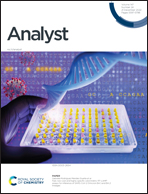A novel electrochemical sensor based on AuPd/UiO-66-NH2/GN composites for sensitive dopamine detection
Abstract
Metal–organic frameworks (MOFs) have emerged as interesting nanomaterials owing to their large surface area, high porosity, tunable pore architecture and easy functionalization. However, an inferior electrical conductivity hinders their application in electrochemical sensing. In this paper, gold–palladium alloy/UiO-66-NH2/graphene (AuPd/UiO-66-NH2/GN) composites were synthesized by loading alloys on the surfaces of MOFs and then attaching them to the graphene surface. The addition of metal nanoparticles and graphene enhanced the electron transfer ability of MOFs. Then, composites were used to modify a glassy carbon electrode (GCE) to construct a sensitive dopamine (DA) electrochemical sensor. The developed sensor manifested two linear relationships in lower concentration ranges and in higher concentration ranges with a 0.21 × 10−6 mol L−1 low detection limit (3σ/k) under optimal conditions. The results certified that the constructed sensor had high selectivity, excellent reproducibility and good stability, and had been used successfully for DA detection in actual human serum samples.

- This article is part of the themed collection: Analyst HOT Articles 2022


 Please wait while we load your content...
Please wait while we load your content...